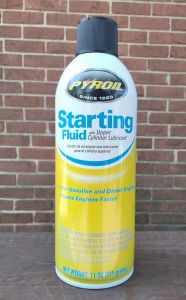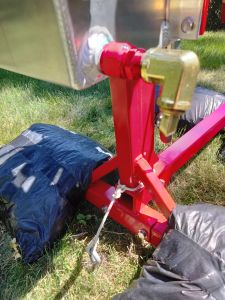


Restoring the 1944 Righter 4‑O‑34 Engine to Running Condition
Part 3: Running the Engine
by Tom Fey
Published 21 Jul 2022; Revised 29 Jul 2022
| Part 1: The Engine | Part 2: Engine Mount and Running Stand | Part 3: Running the Engine |
| With engine, stand and propeller complete, now comes the really fun part: The First Start. I have no manuals for the 4-O-34A, but I have acquired a few years of experience starting and running similar drone engines. And they are simple beasts. |
These engines are relatively low compression and can use fuel of 73 to 100 octane, although the post- war 0-45-35 with a compression ratio of 6.2:1 does specify 91 octane fuel. Outside of Chicago city limits I can buy ethanol-free gasoline of 90 to 92 octane which is preferred by boat, ATV, vintage car, and WWII drone engine operators.
Fuel/oil mixtures specified in the other manuals require anywhere from 6:1 fuel/oil ratios (Righter O-45-1) down 10:1 (Herkimer 2-GS-17) using 20 to 40 weight motor oil. Modern 2 stroke oils have magical lubrication properties unimagined in 1944, allowing fuel-oil ratios of 32:1 up to 50:1 in current engines. I maintain the 8:1 ratio for my engines because that is what it says in the manuals and any modern lubricity benefit helps insure the longevity of these relics. The vintage Champion 6-COM-62 sparks plugs have had no issue with the higher oil ratios.
Like my other drone engines, my ignition system has been converted to 12-volt coils and modern condensers for simplicity and reliability. Motorcycle dual coils of 3 to 5 Ohms resistance and of various types and manufacturers have been used successfully to run the WWII drone engines. I’ve come to learn the Righter 4-O-34 and some of the other drone engines use Eisemann H24 104 magneto points, although I have yet to replace any of the original points on my engines. A fully charged 12-volt battery of at least 7 amp-hour capacity will run the fuel pump and coils just fine.
In my opinion any drone engine over 8 horsepower should be tethered to the ground with a screw anchor and lanyard. All drone engine stands need to be stabilized for starting. Wheel chocks for hard surfaces, or driving the wheels into the dirt on grass, coupled with 60-pound sand bags on each arm of the stand will do the job. A fire extinguisher should always be on hand, and I check the torque on the propeller nuts before every session.
I hand-prop my engines under 20 horsepower. Above 20 hp, I use a sling over the prop blade for two-hand, full body leverage and to remove myself from in front of the propeller. In all case, remove hats, watches, lanyards, pocket contents, phones, jewelry, etc. before-hand propping. Should such things fly loose during starting, there is a natural tendency to grab for them, and that increases the odds you’ll make the Internet highlight reels or 10 o’clock news. I wear a tether on my glasses and my tight-fitting noise reduction headphones help keep them in place. Hearing protection is essential.
In addition to an emergency cutoff pull-pin, I installed a large knife switch on the 4-O-34 stand to make sure the person hand-propping the engine can confirm whether the engine is armed to fire or not. I call it my anti-stupid device.
I’m right-armed, so I place my right foot on the port sandbag, drift my left foot back maybe 6 inches behind the starboard sandbag, feet at a little over shoulder width. I align my right shoulder joint so it is centered on the propeller shaft. This geometry gets my best power when the propeller is vertical at which time the pistons are at top dead center when they fire. It also assures my hand is exiting rapidly from the arc of the propeller and moving forward and away in front of the plane of the propeller when my hand comes off the blade. I wear secure work gloves for hand-propping.
I was unsure how many turns out to make on the 4-O-34 carburetor mixture needle or how best to utilize the choke. There is no throttle on this carburetor and the ignition timing was retarded to fire at top dead center.
I decided three turns out on the needle and four cold pulls under full choke should be reasonable starting point. After a long series of starting attempts where I could not smell fuel out of the exhaust stacks, we went to 4, then 5 turns out on the needle. Ultimately, a blast of aerosol starting fluid down the carb was tried. I called it “… a spray can of loser…” in the video, but anything to get the first few pops is tremendous progress. We were out there for two hours.
 |
 |
 |
| Pic 1. Engine ready to run. Off center, sandbagged ladder holds GoPro camera. | Pic 2. Spray can of loser. | Pic 3. Stand is tethered to ground screw anchor. |
As can be seen on the video, the engine would run mostly run on prime and ether until we backed the mixture needle out further, all the way to 5 turns. Eventually, we got a 45 second run where the engine seemed immune to changes in mixture needle setting, and it soon became clear by the lukewarm front cylinders that they were firing maybe 5% of the time. So, either the timing was off, the coil/points/condenser, or plug wires for the front cylinders were to blame. But it ran. The tach, which counts impulses on one spark plug wire, indicated around 4,000 rpm, which was twice the expected rpm. I re-set the tach to the “two sparks per revolution” setting, which makes no sense, but should do the job. Engine speed is easily controlled by mixture and spark timing.
The front coil tested out fine as did the timing setting, but spark was inconsistent. I removed the engine from the stand, removed the front points, cleaned adjusted, and re-timed the front points. Then I replaced the original vintage condenser with a new, modern condenser. Boom, the front sparks were now stronger than the rear sparks. So, I installed two new Harley-Davidson condensers.
It took six days for my exhausted right deltoid to return to normal function. I got the engine all set up, on goes the GoPro camera, 4.5 needle turns out on the carb, full retard on the ignition, four cold pulls on the engine, one shot of starting fluid, two cold pulls for the ether, switch on, and it started on the second pull. It ran rich, smokey, with a four-cycle sound. I leaned the needle to about three turns out and the two-cycle whine revealed itself. The engine was idling around 2,100 rpm. It would occasionally stumble accompanied by a puff of oil smoke, like the ignition was cutting out. I slowly advanced the ignition to the full 26°, the rpm picked up to about 3,000 rpm, and the mis-firing disappeared. After a few seconds, back to full retard and the mis-firing reappeared. I shut it down after 1.5 minutes.
Examining the plug wires, I could feel two of the spark plug connectors rattling on their spark plug grooves while the two others remained snug. I removed the connector from the plug and pinched the brass prongs tighter. Once all four were snug, I restarted the still-warm engine on the 15th pull. The mis-firing was gone and as can be seen on the video, I cycled the engine through leaning down to 2 turns out and full advance, all of which yielded 3,400 rpm on the tach. I backed away from the engine a couple times and removed my hearing protection. It is magnificently and stupendously loud. The 4-O-34 is the smoothest running of all my drone engines with none of the buzz felt on the carb needle of the 20 hp Kiekhaefer 0-45-1. But I think they are tied for decibel level, the latter being more basso profundo.
There were two mis-fires in the 2.2-minute run, both at idle speed, and I once again found a rattling spark plug connector. I think at high rpm the wind tensions the plug wires, but much less so at idle rpm. Even at idle an of 2,000 rpm, the plugs are firing 33 time per second, so this looseness needs to be remedied one way or another before run number 4.
Once the engine cools I put foam plugs in the exhaust ports and carburetor intake to keep the moisture and bugs out. The tachometer Hourmeter now registers 0.1 hours.
I’ll check the mounts for cracks, all the nuts for tightness, especially the prop nuts, and the fuel lines for leaks. But that is for later; for now, I couldn’t be happier.